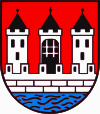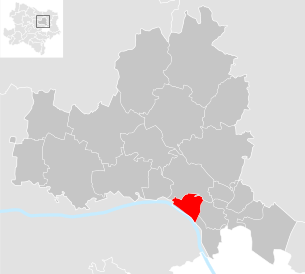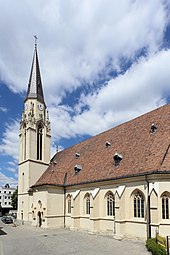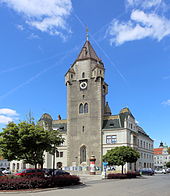Korneuburg
|
Borough Korneuburg
|
||
|---|---|---|
| coat of arms | Austria map | |
|
|
||
| Basic data | ||
| Country: | Austria | |
| State : | Lower Austria | |
| Political District : | Korneuburg | |
| License plate : | KO | |
| Surface: | 9.71 km² | |
| Coordinates : | 48 ° 21 ' N , 16 ° 20' E | |
| Height : | 168 m above sea level A. | |
| Residents : | 13,331 (January 1, 2020) | |
| Population density : | 1,373 inhabitants per km² | |
| Postal code : | 2100 | |
| Area code : | 02262 | |
| Community code : | 3 12 13 | |
| NUTS region | AT126 | |
| Address of the municipal administration: |
Hauptplatz 39 2100 Korneuburg |
|
| Website: | ||
| politics | ||
| Mayor : | Christian Gepp ( ÖVP ) | |
|
Municipal Council : ( 2020 ) (37 members) |
||
| Location of Korneuburg in the Korneuburg district | ||
 Main square with the neo-Gothic town hall and behind it the late-Gothic city tower. |
||
| Source: Municipal data from Statistics Austria | ||

Korneuburg is a municipality in the Lower Austrian Weinviertel with 13,331 inhabitants (as of January 1, 2020). It is both the seat of the district authority of the district of the same name as well as the district court of Korneuburg .
geography
Korneuburg is located in the Weinviertel in Lower Austria on the Danube , 12 km northwest of Vienna . The area of the municipality covers 9.71 square kilometers. 20.76 percent of the area is forested.
The Korneuburg Basin extends from here about 15 kilometers to the north.
Community structure
The Korneuburg district is divided into 20 communities. These are:
- Bisamberg (4,769 inhabitants, 10.77 km²)
- Enzersfeld in the Weinviertel (1,733 inhabitants, 9.85 km²)
- Ernstbrunn (3,204 inhabitants, 80.72 km²)
- Gerasdorf near Vienna (11,294 inhabitants, 35.24 km²)
- Großmugl (1,599 inhabitants, 64.47 km²)
- Großrußbach (2,227 inhabitants, 32.76 km²)
- Hagenbrunn (2,220 inhabitants, 13.5 km²)
- Harmannsdorf (4,018 inhabitants, 55.58 km²)
- Hausleiten (3,747 inhabitants, 61.14 km²)
- Korneuburg (13,246 inhabitants, 9.71 km²)
- Langenzersdorf (8,106 inhabitants, 10.67 km²)
- Leitzersdorf (1,189 inhabitants, 27.89 km²)
- Leobendorf (4,872 inhabitants, 30 km²)
- Niederhollabrunn (1,540 inhabitants, 50.36 km²)
- Rußbach (1,434 inhabitants, 30.7 km²)
- Sierndorf (3,962 inhabitants, 55.09 km²)
- Spillern (2,324 inhabitants, 12.7 km²)
- Stetteldorf am Wagram (1,035 inhabitants, 25.73 km²)
- Stetten (1,361 inhabitants, 7.74 km²)
- Stockerau (17,010 inhabitants, 37.44 km²)
Neighboring districts
- Hollabrunn district
- Tulln district
- District Floridsdorf ( Wien )
- Mistelbach district
- District Donaustadt (Vienna)
history
In the Geographike Hyphegesis of Claudius Ptolemaios a place in this area is called Mediolanion . Originally developed from a riverside settlement, Korneuburg was connected to Klosterneuburg for centuries under the common name Nivenburg . The connection was a ford through what was then the arms of the Danube. The Latin name was Corena Nova . In 1136 it was mentioned for the first time in the founding document of the Benedictine monastery Klein-Mariazell, as a new marketplace - novum forum, forum trans Danubium . In 1298, Korneuburg was granted city rights by Duke Albrecht I , which resulted in the formal separation from Klosterneuburg.
The city layout clearly corresponds to a Silesian foundation scheme. It is noteworthy that Korneuburg is the only Austrian town with a typically Silesian central, regularly rectangular "Ringplatz", ie with a large market that surrounds the town hall and another island of houses, called " Grätzl " or "Kretzl" in Lower Austria .
Away from the main square, which has an urban ambience with its patrician houses, the urban structure begins to have clearly village features. Single-storey houses define the cityscape, and some single-family houses are already close to the main square. The appearance of the city was fundamentally redesigned in the second half of the 19th century.
Due to its status as a sovereign fortress , Korneuburg was repeatedly fought over in various wars, for example during the wars between the Hungarian King Matthias Corvinus and Friedrich III. After the war between the two rulers broke out again in 1482, the Hungarian troops occupied large parts of the Habsburg hereditary lands. To this end, King Matthias had raised three armies, of which the army led by István Dávidházy († 1484) besieged Bruck an der Leitha , the army commanded by Tobias von Boskowitz and Černahora was supposed to conquer other places in Lower Austria and secure the troops besieging Bruck, and the third army marched into Styria and Carinthia to defeat the armed forces of Friedrich III. to tie.
After Bruck and his citadel had fallen, the Hungarians began the siege of Korneuburg in April 1484, which also served the purpose of cutting through Vienna. Friedrich III. wanted absolutely to prevent the loss of Korneuburg. He sent a field army to relieve the city, but they suffered a defeat in the battle of Leitzersdorf . With the outcome of the battle, not only Korneuburg's fate but also Vienna was sealed, and both cities finally fell to the Hungarian king.
Korneuburg was also the battleground in the following centuries, for example during the Thirty Years' War . When the Swedes occupied large parts of Lower Austria in the final phase of the war and advanced as far as Vienna, on April 4, 1645, Colonel Lukas Spicker, the commandant of Korneuburg Fortress and Kreuzenstein Castle , was requested to hand over both defensive sites. In view of the small number of troops he had at his disposal, Spicker immediately complied with the request and handed the castle and town over to the Swedish troops commanded by Field Marshal Lennart Torstensson on April 5 without a fight . Before the main Swedish armed forces withdrew to Moravia at the end of September 1645, Torstensson had the Korneuburg fortress reinforced and a strong garrison with sufficient ammunition and provisions was placed in it. In this way, the fortress was to serve as a starting point for a possible storm on Vienna in the following year. This did not happen, however, and the Swedish garrison of Korneuburg was under siege by imperial troops from May 1646 . After an attempt at relief had proved impracticable, the Swedish fortress commander Colonel Johann Copy finally surrendered in early August 1646. Korneuburg's fortress walls had been badly damaged during the persistent fighting.
During the Turkish siege of Vienna in 1683 and also during the Napoleonic Wars , Korneuburg was also a theater of war. Immediately after the Battle of Wagram in July 1809, a battle between the retreating Austrian rearguard and the advancing French troops broke out near Korneuburg .
In 1927 the Korneuburg refinery went into operation. In 1958 the Korneuburg power plant followed .
On May 18, 1930, the so-called Korneuburg Oath was taken in the city . At that time, Christian-social Heimwehr took an oath to abolish democracy, professed fascism and the establishment of a "corporate state" .
Korneuburg has been a member of the regional development association 10 vor Wien since 2006 .
Urban development
Korneuburg is playing a pioneering role with its participatory urban development. In a participatory process - i. H. With the participation of politics, administration and citizens - in 2014 the model “Life in the Confluence” and in 2016 the master plan by 2036 were completed.
Korneuburg has received Austrian and European recognition for its urban planning activities and innovative forms of public participation:
- ÖGUT environmental award 2016 in the category 'Participation and civil society engagement'
- URBACT Good Practice Cities Award 2017 for Integrated Urban Development
Population development

Since the second half of the 19th century, Korneuburg has recorded a steady, and between 1880 and 1890 even rapid (+ 38% in just ten years) population growth. Declines were brought about by the war years (between 1910 and 1923 −4.4% and between 1939 and 1951 even −20.4%). Since then the population has increased. The increase from the penultimate census in 1991 to the last census in 2001 was 13.4% and is exclusively due to the immigration balance (+13.6%), since the birth balance was slightly negative (-0.2%).
Religions
The majority of the population (68.4%) is Roman Catholic , 4.2% are Protestant , 3.6% are Orthodox Christians. 3.1% profess Islam . 17.5% are without religious belief .
politics
The municipal council has 37 members.
- With the municipal council elections in Lower Austria in 1990, the municipal council had the following distribution: 18 SPÖ, 13 ÖVP, 1 FPÖ and 1 Greens. (33 members)
- With the municipal council elections in Lower Austria in 1995, the municipal council had the following distribution: 16 SPÖ, 11 ÖVP, 3 FPÖ, 2 Greens and 1 LIF.
- With the municipal council elections in Lower Austria in 2000, the municipal council had the following distribution: 18 SPÖ, 10 ÖVP, 3 FPÖ and 2 Greens. (33 members)
- With the local council elections in Lower Austria in 2005 , the local council had the following distribution: 19 SPÖ, 13 ÖVP, 4 Greens and 1 FPÖ.
- With the municipal elections in Lower Austria in 2010 , the municipal council had the following distribution: 18 ÖVP, 14 SPÖ, 3 Greens and 2 FPÖ.
- With the municipal council elections in Lower Austria in 2015 , the municipal council had the following distribution: 22 ÖVP, 9 SPÖ, 4 Greens and 2 FPÖ.
- With the municipal council elections in Lower Austria 2020 , the municipal council has the following distribution: 22 ÖVP, 9 SPÖ, 4 Greens, 1 NEOS and 1 FPÖ.
- mayor
- until 2010 Wolfgang Peterl (SPÖ)
- since 2010 Christian Gepp (ÖVP)
Culture and sights
- Catholic parish church of St. Giles : A Gothic stacked church with a high roof on the northern edge of the old town. The choir , the sacristy and the south aisle were built in the 2nd half of the 14th century. Originally the church had twin towers; the northern one was removed during extensive renovations in the 17th century. In 1846 the central nave was vaulted in a neo-Gothic style. Another profound renovation took place from 1870 to 1903. Among other things, the tower and the west facade were rebuilt here.
- Augustinian Church of the former Augustinian Hermit Monastery : The monastery was founded in 1338 by Otto the Merry , the church was rebuilt from 1745 to 1773 by an unknown master. The baroque equipment, u. a. the high altar fresco “The Last Supper” is by Franz Anton Maulbertsch . The tower was built by Max Kropf in 1898 .
- Korneuburg Town Hall : Built under Max Kropf , opened in 1895. On the facade are the statues of Emperor Franz Josef and Duke Albrecht I as well as the coats of arms of the former crown lands and other important Lower Austrian cities. Inside there is a coat of arms ceiling, the only coats of arms of bourgeois families of the 15th and 16th centuries. Century shows, among other things, the first mayor of the city, Andreas Ramler (1406), and Niklas Engelgershauser, who earned services to the rapid reconstruction of the city after the fire of 1417.
- City tower: The late Gothic city tower, which was built between 1440 and 1447, also belongs to the city hall . When Count Puchheim regained the city for Austria during the Thirty Years War, the tower was badly damaged. During the renovation in 1890, it was redesigned and received its current appearance. On the four main sides the Babenberg shield , the Lower Austrian state coat of arms, the Reich coat of arms and the city coat of arms can be seen. Its main tasks were to find enemies and fire quickly.
- Pied Piper Fountain: erected in front of the town hall in 1898 to replace two pump wells. With the statue of the Pied Piper , made by the sculptor Emanuel Pendl , an old local legend about the events of 1646, the end of the siege of Sweden , has been preserved in memory. The fountain itself was created in a monumental manner entirely from Kaiserstein , the white, hard Kaisersteinbrucher stone.
- Korneuburg synagogue (ruin): built between 1306 and 1325, confiscated in 1420 and then used for various purposes (e.g. as a granary), under monument protection since 1980, there have been plans to restore it since 1999.
traffic
- Roads: Since Korneuburg is located at the intersection of several traffic routes, the traffic load is enormous. Due to the immediate proximity to the Danube bank motorway (A22) and the proximity to the Vienna outer ring expressway (S1), the traffic load in the Korneuburg region will increase further. Urban development is significantly influenced by these two busy roads.
Furthermore, Korneuburg is driven through by Donau Straße (B3) and Laaer Straße (B6). With the mobility concept drawn up from 2015 to 2017 and approved by the municipal council in September 2017, the municipality wants to get the burden of individual motorized traffic under control despite the massive population growth.
- Taxi ferry: The Korneuburg – Klosterneuburg taxi ferry is available to reach Klosterneuburg on the opposite bank of the Danube .
- Train / bus: Korneuburg can also be reached directly by regional trains and rapid transit trains from Vienna via the main S-Bahn line.
In addition, regional buses , a collective call taxi (AST) and nextbike rental bikes are available. The mobility concept of the municipality of Korneuburg provides for an improvement of the offer in the environmental network (public transport, bike, pedestrian).
Public facilities
dishes
One of the four Lower Austrian regional courts has its seat in Korneuburg . Its district essentially comprises the entire Weinviertel ( district courts Gänserndorf , Mistelbach , Korneuburg and Hollabrunn ), as well as the region along the southern bank of the Danube up to the state border to the east (district courts Bruck an der Leitha and Schwechat ) as well as the cities of Klosterneuburg and Gerasdorf (District Court Klosterneuburg). The Korneuburg Regional Court itself is part of the Vienna Higher Regional Court . It currently employs around 30 judges. In 2012, the regional and district courts as well as the public prosecutor's office - previously located on the main square - started work at the new location at Landesgerichtsplatz 1 (near the Donauauen).
schools
- Branch of the school for general health and nursing care Stockerau
- Special educational kindergarten
- 2 elementary schools
- General special school
- Music creative middle school
- New Lower Austria Middle School Sport and Creative
- Music school of the Korneuburg music lovers
- Polytechnic school
- BG and BRG of the municipality of Korneuburg
- Korneuburg Adult Education Center
- Federal Trade Academy
- private school with public rights based on Montessori pedagogy
- SDV computer science school
health
- Landesklinikum Weinviertel Korneuburg
- Lower Austrian regional health insurance fund
- Korneuburg State Nursing Home
- Health house
- Korneuburg relief organization
- Islamic culture and aid organization Korneuburg
- Red Cross Korneuburg
- Therapy center Korneuburg
military
- Dabsch-Kaserne ( NBC defense school , AFDRU units )
- Albrechts barracks and chamber office building (military use until 1955)
- Franz-Joseph-Infanterie-Kaserne (military use during the Austro-Hungarian Empire)
Other facilities
- Labor market service
- BEV surveying office
- Korneuburg probation service
- District Chamber of Farmers , Chamber for Workers and Salaried Employees (AK, ÖGB)
- District authority Korneuburg
- Dimmi-Arena , multi-purpose stadium
- Hollabrunn Korneuburg Tulln tax office
- police
- Juvenile detention center
- State Youth Home Korneuburg
- Lower Austria Regional Building Authority I
- Public notary
- Österreichische Post Aktiengesellschaft, Korneuburg Post Office, PSK
- Roman Catholic Church contribution office (branch office)
- Municipality of Korneuburg
- Korneuburg Cultural Center with Korneuburg City Museum
- Volunteer fire brigade of the city of Korneuburg
Personalities
- Sons and daughters of the church
- Johann Holzer (1753–1818), composer
- Johann Georg Lickl (1769–1843), composer
- Franz Wirer von Rettenbach (1771–1844), court doctor and founder of the Bad Ischl spa
- Max Burckhard (1854–1912), director of the kk Hofburgtheater (Vienna Burgtheater)
- Karl Liebleitner (1858–1942), teacher, choirmaster and folk song researcher
- Karl Elleder (1860–1941), caricaturist and illustrator
- Nico Dostal (1895–1981), operetta and film music composer
- Richard Henke (1900–1963), chemist and inventor
- Viktor Matejka (1901–1993), writer and cultural worker and politician
- Herbert Killian (1926–2017), historian and victim of Stalinism
- Kurt Binder (* 1944), physicist
- Hannes Kottek (1958–1994), jazz musician
- Helmuth Lehner (* 1968), black metal musician
- Mario Majstorović (* 1977), football player
- Benjamin Swiczinsky (* 1982), animator
- Nada Ina Pauer (* 1986), long-distance runner
- Thomas Kunert (* 1988), beach volleyball player
- Florian Feik (* 1989), theater and film actor
- Stefan Matzner (* 1993), racing cyclist
- David Kickert (* 1994), ice hockey goalkeeper
- Jana McKinnon (* 1999), Austrian-Australian actress
- Matthias Tschrepitsch (* 1999), ice hockey goalkeeper
- People related to the community
- Liborius Hausner Edler von Hauswehr (1834–1925), Austro-Hungarian Field Marshal Lieutenant
- Andreas Minnich (* 1974), entrepreneur and politician
literature
- Rudolf Finz, Evelyn Drescher: Korneuburg . From the turn of the century until today. Museum Association, Korneuburg 1984.
- Hermann Kittel: Beggar turning back - Tasty Uschtarivari . Illustrated Korneuburg street chronicle. In: Local History . 1st edition. Edition Weinviertel, Gösing / Wagram 2006, ISBN 978-3-901616-82-2 .
- Commission for the publication of a historical atlas of the Alpine countries of Austria (ed.): Building age plans of Austrian cities / Lower Austria: Tulln , Korneuburg, Traismauer . 1st edition. Delivery 2nd publishing house of the Austrian Academy of Sciences, 1974, ISBN 3-7001-2038-9 .
- Norbert Nemec: Korneuburg in the Middle Ages . Norbert Nemec, Vienna 2006.
- Ludwig Ried: King Albrecht I of Habsburg and its importance for the city of Korneuburg. 1298-1988 . Municipality of Korneuburg 1998.
- Albert Starzer: History of the princely city of Korneuburg . Korneuburg Museum Association, 1991 (facsimile print of the 1899 edition).
- Klaus Köhler: “Such a terribly torn life”. Life and fate of the Jews in the Korneuburg district. 1848-1946 . Almond Tree Science, Vienna 2013.
Web links
- Side of the city of Korneuburg
- 31213 - Korneuburg. Community data, Statistics Austria .
- Entry on Korneuburg in the database of the state's memory for the history of the state of Lower Austria ( Museum Niederösterreich )
- Revisiting the Transit Camp at Korneuburg after 58 Years (English)
- City history of Korneuburg on the side of the city of Korneuburg
Individual evidence
- ^ Peter Broucek: The Swedish campaign to Lower Austria 1645/46. (= Military History Series, Issue 7) Österreichischer Bundesverlag Ges.mbH, 3rd edition, Vienna 1989, ISBN 3-215-01654-0 , pp. 10, 20f and 23.
- ↑ Mission statement 'Life in the Confluence'
- ↑ Master plan up to 2036 (Version 1.0)
- ^ Result of the local council election 1995 in Korneuburg. Office of the Lower Austrian State Government, March 30, 2000, accessed on February 10, 2020 .
- ^ Election result of the municipal council election 2000 in Korneuburg. Office of the Lower Austrian State Government, February 4, 2005, accessed on February 10, 2020 .
- ^ Election result of the municipal council election 2005 in Korneuburg. Office of the Lower Austrian State Government, March 4, 2005, accessed on February 10, 2020 .
- ^ Election result of the municipal council election 2010 in Korneuburg. Office of the Lower Austrian State Government, October 8, 2010, accessed on February 10, 2020 .
- ^ Election result of the 2015 municipal council election in Korneuburg. Office of the Lower Austrian State Government, December 1, 2015, accessed on February 10, 2020 .
- ↑ Results of the municipal council election 2020 in Korneuburg. Office of the Lower Austrian State Government, January 26, 2020, accessed on February 10, 2020 .
- ^ DEHIO Lower Austria north of the Danube . Berger Verlag, Horn / Vienna 2010, ISBN 978-3-85028-395-3 , p. 539ff.
- ↑ Garage or what? ( Memento of the original from May 4, 2014 in the Internet Archive ) Info: The archive link was inserted automatically and has not yet been checked. Please check the original and archive link according to the instructions and then remove this notice. (PDF; 472 kB) Publication of the ARGE Jewish Life in Korneuburg
- ↑ This site requires a frames-compliant browser .: Mobility concept and survey results . In: Korneuburg . ( korneuburg.gv.at [accessed on October 26, 2017]).
- ↑ AST Info. City of Korneuburg










